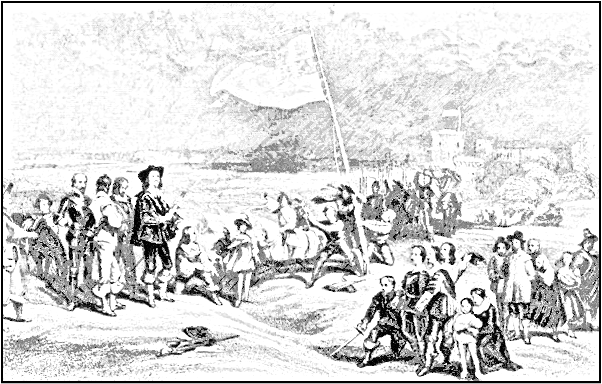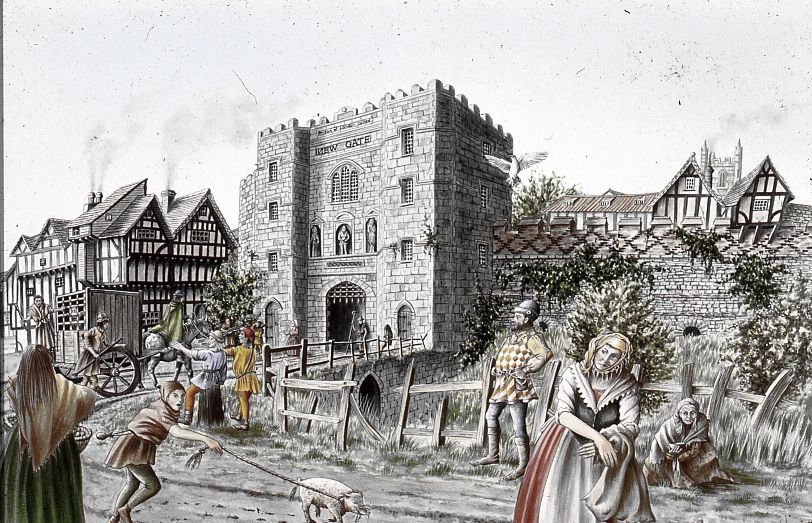
This is the day when the English Civil War began. The King had been in York, and as he traveled South he was refused entry to first Hull, then Coventry. Attempts to mediate the dispute between King and Parliament were proving fruitless. King Charles I decided to call the people to join him to protect the Monarchy. He chose to do it at Nottingham, as he was hoping for a supply of weapons to come from Holland where his wife was. The weapons could come up the Trent to Nottingham. Also it was closer to London than other possible locations.
It was a wet day, and not many people had responded to the King’s military appeal. The King’s sons and nephews were there with a few courtiers and heralds.
They went to the top of Nottingham Castle. At the last moment the King decided to amend the statement that the Herald would deliver. So as the trumpets sang and the Royal Standard was unfurled the Herald found difficulty in reading the King’s writing. It added to a right Royal washout. 6 days later the Standard was blown down by the wind.
The Royal Standard
What did the Standard look like?
I was happy to come across this post by Alan Turton who has researched what the Royal Standard might have looked like. These are his drawings of the two sides of the Standard.


The motto means ‘God and my Right’. It expresses what got Charles to this unhappy pass. He believed he had a divine right to rule. Parliament thought he had to rule according to the laws of the land, Magna Carta and with the consent of Parliament.
What lead up to the raising of the standard?
How did it get this far? I will be posting further posts on the Civil War over the next year. But, for now, here is preview:
Charles had ruled without Parliament for 9 years, and ruled arbitrarily against the tenets of Magna Carta. Then he stumbled into a war in Scotland which he lost. So he needed to call Parliament. Parliament said yes, we can provide you with money, but only if you rule as a constitutional monarch.
On 4th of January 1642, Charles I attempted to regain the powers he had given away. He planned to arrest the leaders of Parliament. The King delayed his coup so that the 5 members John Hampden, Arthur Haselrig, Denzil Holles, John Pym and William Strode were forewarned. They fled to seek the protection of Puritans in the City of London.
The King followed, again waiting a day. When he got to the Guildhall the mob was out in force, and he was met by crowds of Londoners, shouting ‘Liberty of Parliament.’ He fled back to Westminster, and on January 10th went to Hampton Court. He then moved north.
Negotiations between King and Parliament continued, while both sides starting arming themselves. The House of Commons and House of Lords, on June 1st, sent the King ‘Nineteen Propositions’. The King rejected them while he was in York.
Towns and Counties began declaring for one side or the other. The King marched towards Kingston-upon-Hull on the Humber where he had a stash of weapons left over from his unsuccessful campaign against the Presbyterians in Scotland. The recently Parliamentary-appointed Military Governor resisted the Royal forces, and the King retreated towards Nottingham.
The King then Raised the Standard to recruit subjects to join his army. He only had 800 mounted troops and 3000 foot soldiers. Parliament could raise double this from London alone.Troops were raised from the County or Borough Militias.
The Parliamentary forces were led by Lord Essex, who blocked the route to London. There followed two indecisive battles, which the Royalists ‘won’. At Edgehill the Royalist cavalry, swept both flanks of the Parliamentary Army away. What would have been a decisive victory was lost when Prince Rupert’s troops just kept pursuing their defeated flank rather than regrouping and attacking the King’s centre.
But the way was clear to London. Prince Rupert beat a small force of Londoners at Brentford. The Royalists marched to Turnham Green, in what is now Chiswick in West London. On November 13th, the two sides met. The outcome of which would decide the course of the Civil War.
First written August 2025
Discover more from And Did Those Feet
Subscribe to get the latest posts sent to your email.
